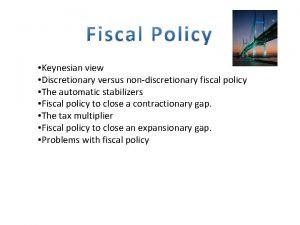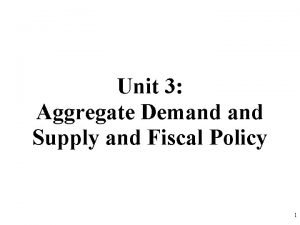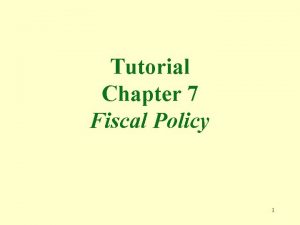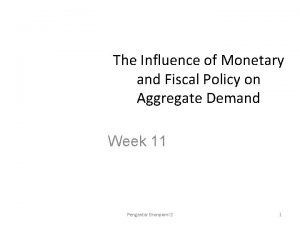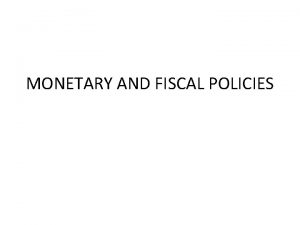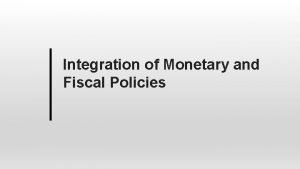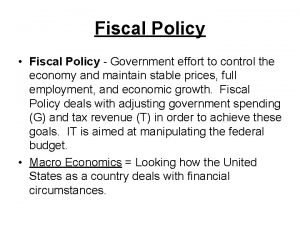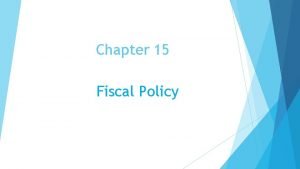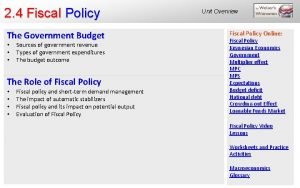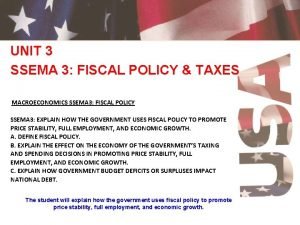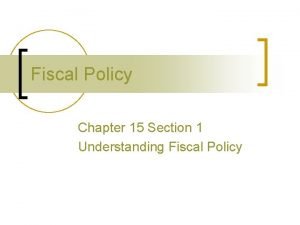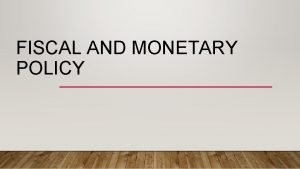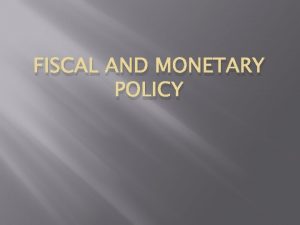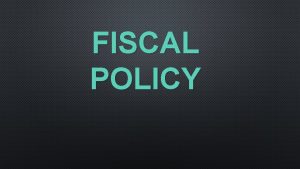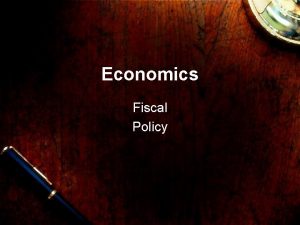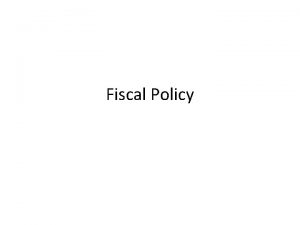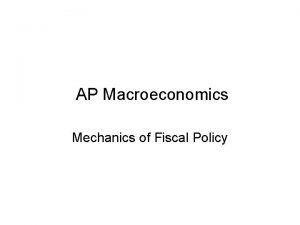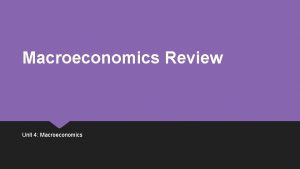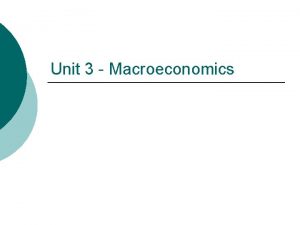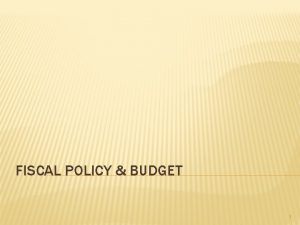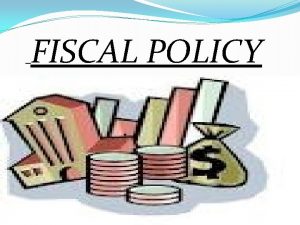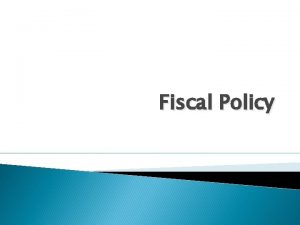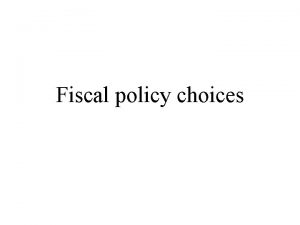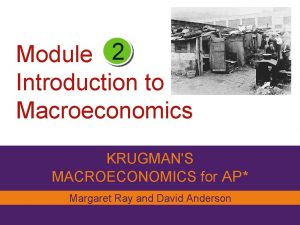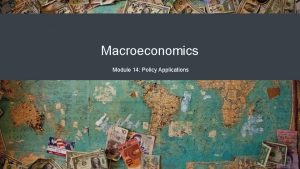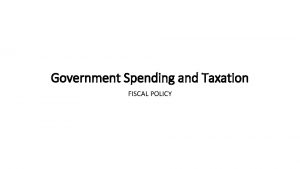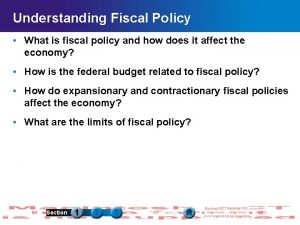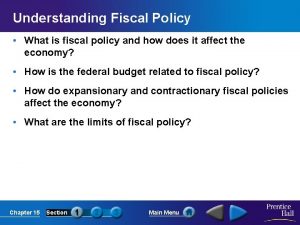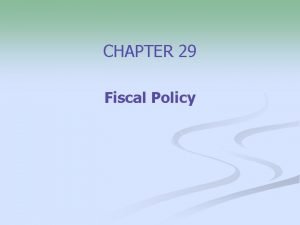Macroeconomics Module 11 Fiscal Policy Fiscal Policy and

























- Slides: 25

Macroeconomics Module 11: Fiscal Policy

Fiscal Policy and the Federal Budget • Fiscal Policy: changes in Federal government spending or tax rates for the purpose of influencing the macroeconomy • • • Fiscal policy is one of two policy tools for managing the economy (monetary policy is the other) Fiscal policy is decided by Congress and the President The discussion of fiscal policy focuses on how federal government taxing and spending affects aggregate demand

Government Spending • Balanced Budget: when government spending and taxes are equal • Budget Deficit: when the federal government spends more money than it receives in taxes in a given year • Budget Surplus: when the government receives more money in taxes than it spends in a year

Total U. S. Government Spending • • Government spending covers a range of services provided by the federal, state, and local governments Federal spending in nominal dollars (that is, dollars not adjusted for inflation) has grown by a multiple of more than 38 over the last four decades

State and Local Government Spending • Spending by state and local government increased from about 10% of GDP in the early 1960 s to 14– 16% by the mid-1970 s. It has remained at roughly that level since. The single biggest spending item is education, including both K– 12 spending and support for public colleges and universities, which has been about 4– 5% of GDP in recent decades. Source: (Source: Bureau of Economic Analysis. )

Taxation • • Ability to Pay Principle: normative argument that citizens with more income or wealth should bear more of the cost of social programs by paying a higher tax rate, since they have a greater ability to pay Benefit Principle: normative argument that tax payers should pay in proportion to the benefit they receive Corporate Income Tax: a tax imposed on corporate profits Estate and Gift Tax: a tax on people who pass assets to the next generation— either after death or during life in the form of gifts Excise Tax: a tax on a specific good—on gasoline, tobacco, and alcohol Flat Tax: proportional income tax system where all individuals pay the same income tax rate Individual Income Tax: a tax based on the income, of all forms, received by individuals

Taxation (cont. ) • • Marginal Tax Rates: the tax one pays on the higher income one earns; Payroll Tax: a tax based on the pay received from employers; the taxes provide funds for Social Security and Medicare Progressive Tax: a tax that collects a greater share of income from those with high incomes than from those with lower incomes Property Taxes: taxes based on the value of your home or other real estate Proportional Tax: a tax that is flat percentage of income earned, regardless of level of income Regressive tax: people with higher incomes pay a smaller share of their income in tax Sales Tax: taxes as a percentage of one’s retail purchases

Federal Taxes • Federal tax revenues have been about 17– 20% of GDP during most periods in recent decades. The primary sources of federal taxes are individual income taxes and the payroll taxes that finance Social Security and Medicare. Corporate income taxes and social insurance taxes provide smaller shares of revenue.

Progressive, Proportional, and Regressive Taxes • Taxes can be categorized as progressive, proportional or regressive based on how their marginal tax rate changes as income goes up. • A tax is progressive if you pay a higher marginal tax rate as your income rises. • A tax is proportional if your tax rate doesn’t change as your income rises; i. e. you pay the same rate at every income level. • A tax is regressive if you pay a lower marginal tax rate as your income rises.

State and Local Taxes • The main revenue sources for state and local governments are sales taxes, property taxes, and revenue passed along from the federal government • Many state and local governments also levy personal and corporate income taxes, as well as impose a wide variety of fees and charges • Some states rely more on property taxes, some on sales taxes, some on income taxes, and some more on revenues from the federal government

Federal Budgets and National Debt • • National Debt: the total accumulated amount the government has borrowed, over time, and not yet paid back The federal government has run budget deficits for decades

Debt/GDP Ratio • • Federal debt is the sum of annual budget deficits and surpluses. Annual deficits do not always mean that the debt/GDP ratio is rising. During the 1960 s and 1970 s, the government often ran small deficits, but since the debt was growing more slowly than the economy, the debt/GDP ratio was declining over this time. In the 2008– 2009 recession, the debt/GDP ratio rose sharply

The Question of a Balanced Budget • • Most economists view the proposals for a perpetually balanced budget with bemusement Economists would expect the budget deficits and surpluses to fluctuate up and down with the economy and the automatic stabilizers Some supporters of the balanced budget amendment like to argue that, since households must balance their own budgets, the government should too There is also no particular reason to expect a government budget to be balanced in the medium term of a few years

Automatic Stabilizers • • • Automatic Stabilizers: tax and spending rules that have the effect of slowing down the rate of decrease in aggregate demand when the economy slows down and restraining aggregate demand when the economy speeds up, without any additional change in legislation Discretionary Fiscal Policy: the government passes a new law that explicitly changes overall tax rates or spending levels with the intent of influencing the level or overall economic activity Standardized (or full) Employment Budget: estimate of the budget deficit or surplus excluding the effects of fiscal policy, that is, as if GDP were at potential

Automatic Stabilizers (cont. ) • • Automatic stabilizers include unemployment insurance, food stamps, and the personal and corporate income tax Automatic stabilizers, like welfare programs such as food stamps, automatically kick in when aggregate demand falls.

Expansionary and Contractionary Fiscal Policy • • Contractionary Fiscal Policy: fiscal policy that decreases the level of aggregate demand, either through cuts in government spending or increases in taxes Expansionary Fiscal Policy: fiscal policy that increases the level of aggregate demand, either through increases in government spending or cuts in taxes

Expansionary Fiscal Policy Expansionary fiscal policies include: 1. increasing consumption by raising disposable income through cuts in personal income taxes or payroll taxes; 2. increasing investments by raising after-tax profits through cuts in business taxes; and 3. increasing government purchases through increased spending by the federal government on final goods and services and raising federal grants to state and local governments to increase their expenditures on final goods and services.

Contractionary Fiscal Policy • • Fiscal policy can also be used to slow down an overheating economy Again, the AD–AS model does not dictate how this contractionary fiscal policy is to be carried out

Neoclassical Fiscal Policy and Supply-Side Economics • • Austerity Programs: measures taken to reduce budget deficits during recessions by raising taxes and cutting government spending Crowding Out: federal spending and borrowing causes interest rates to rise and business investment to fall; crowding out can also be caused by federal tax cuts Flat Tax Income Tax: system where all pay the same tax rate Laffer Curve: hill-shaped relationship between tax rates and tax revenues; if tax rates are high enough, lowering rates actually increases revenues Multiplier Effect: idea that a change in spending causes a more than proportionate change in real GDP Reaganomics: see Supply-Side Economics: belief that economic activity is motivated by after tax returns to that activity, so that tax cuts on personal income increase labor supply, tax cuts on saving increase saving, and tax cuts on investment increase investment

Supply-Side Economics • • • Supply-siders argue that three key elements affect the macro economy: • • • Labor supply, which is determined by wages and salaries after taxes are removed (e. g. takehome pay); Saving, which is determined by the after-tax rate of return to saving; and Business investment, which is determined by the after-tax rate of return to capital investment. A flat tax is proportional, meaning that all individuals or corporations would pay the same tax rate The Laffer Curve is somewhat controversial in practice

Fiscal Policy, Investment, and Crowding Out • Head Start Program: a program for early childhood education directed at families with limited educational and financial resources • Infrastructure: public investment in public and externality goods like roads and transportation features (e. g. airports, seaports), water supply and sewers, schools and hospitals.

Crowding Out Physical Capital Investment • When government conducts an expansionary fiscal policy, it may run afoul of the crowding out effect • Expansionary fiscal policy means an increase in the budget deficit • When government borrowing soaks up available financial capital and leaves less for private investment in physical capital

Public Investment in Physical and Human Capital, and Technology • • • All government spending does not cause crowding out Public infrastructure spending on physical capital can enhance private investment In most countries, the government plays a large role in society’s investment in human capital through the education system Not all spending on educational human capital needs to happen through the government Research and development (R&D) efforts are the lifeblood of new technology Fiscal policy can encourage R&D using either direct spending or tax policy

Quick Review • • What are some examples of fiscal policy? Describe the federal budget and identify deficit and surplus trends over the past five decades Describe state and local government spending, including main expenses What are the major sources of revenue for the U. S. federal budget as well as state and local governments? What is the difference between regressive tax, a proportional tax, and a progressive tax? What is the difference between deficit and debt? Explain how economic growth or decline can influence a budget surplus or budget deficit. Describe the arguments for and against requiring the U. S. federal budget to be balanced.

More Quick Review • • Describe how fiscal policy can be designed to stabilize the economy using automatic stabilizers. Explain how expansionary fiscal policy can increase aggregate demand boost the economy. Explain how contractionary fiscal policy can decrease aggregate demand depress the economy. Explain supply-side economics, including the role of tax cuts and the Laffer curve. Compare and contrast Keynesian and neoclassical approaches to fiscal policy. What is crowding out and its effect on physical capital investment? How is economic growth tied to investments in physical capital, human capital, and technology?
 Fiscal policy definition
Fiscal policy definition Expansionary monetary policy effects
Expansionary monetary policy effects Unit 3 aggregate demand and aggregate supply
Unit 3 aggregate demand and aggregate supply Tax multiplier formula
Tax multiplier formula Discretionary and non discretionary fiscal policy
Discretionary and non discretionary fiscal policy Unit 3 aggregate demand aggregate supply and fiscal policy
Unit 3 aggregate demand aggregate supply and fiscal policy Inflation
Inflation Example fiscal policy
Example fiscal policy Government expenditure multiplier formula
Government expenditure multiplier formula Components of fiscal policy
Components of fiscal policy Crowding out effect of fiscal policy
Crowding out effect of fiscal policy Instruments of fiscal policy
Instruments of fiscal policy Fiscal policy
Fiscal policy Fiscal policy definition
Fiscal policy definition Fiscal demand side policy
Fiscal demand side policy Fiscal policy definition
Fiscal policy definition Contractionary fiscal policy
Contractionary fiscal policy Instruments of fiscal policy
Instruments of fiscal policy Crowding out definition ap macro
Crowding out definition ap macro Demand side fiscal policy definition
Demand side fiscal policy definition Contractionary monetary policies
Contractionary monetary policies Crowding out effect of fiscal policy
Crowding out effect of fiscal policy Example of expansionary fiscal policy
Example of expansionary fiscal policy Fiscal policy
Fiscal policy Goals of fiscal policy
Goals of fiscal policy Fiscal vs monetary policy
Fiscal vs monetary policy




